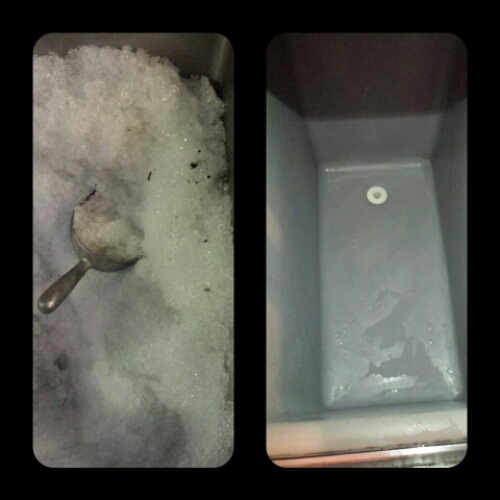Last night, we discovered little black spots in the ice coming out of the ice maker machine. I washed out the water hose connected to the machine and was ready to test out whether the dirty hose was the true culprit. Before reattaching it to the ice maker machine, I started scooping out the ice that had been affected.
I could see the ice on top had black specks in it, but the ice in the middle seemed clean. I thought, Wait, am I throwing away clean ice for nothing? Maybe all the dirty ice has been removed now. I thought back to past experience and decided it’s better to follow through and know for sure, rather than quit mid-way and have lingering doubts.
So I scooped out all of the ice. I found that black dust had collected at the very bottom of the tub. I was glad that I had decided to scoop out all the ice and did a full cleaning. Once I reconnected the water supply, I would know for sure if I had corrected the dirty ice problem at its cause.

Turned out, the water supply wasn’t the issue. After letting the ice machine run, we found more dirty specks in the ice. Again, I scooped out all the ice and cleaned the tub. Then, following the repair guy’s suggestion, I took the machine apart and cleaned out the machine’s water reservoir container. After letting the machine run overnight, we discovered noticeably fewer specks, but they were definitely still there.
Finally, I called the repair guy and told him I had tried everything he recommended but our ice was still dirty. He made a site visit and upon touching the black specks, he informed me that the problem was more serious than he had initially thought. Our options were to pay for an expensive repair or buy a new machine. Because I had personally tried everything possible, I was confident that buying a new machine was the right decision.
Our dhamma practice works in the same way. First, there are the symptoms: irritation, anxiety, discomfort, or in this case, dirty ice. These alert you to the existence of a problem.
Now, and this is often a very difficult part of the process, is to identify the cause of the problem. The water supply was tested and eliminated as the cause. The hose and reservoir were merely factors that contributed to dirty ice. Just like cleaning out the tub can help eliminate doubt as to the real culprit, we must also ask ourselves good questions that can help us pinpoint the true cause. For example, if you change the person who said it, would you still be annoyed? What if you changed a detail of the situation, like the location? How do these changes affect the result?
Then, after testing out the cause by giving it time to produce results, you have to reassess whether your approach is working. We let the ice run overnight and saw some improvement, but it was obvious we hadn’t tapped into the true cause. So we had to call in an expert, someone who had dealt with similar situations successfully. Sometimes the expert is a friend who isn’t so deeply involved with the situation, who can help you see things objectively. Sometimes it is someone like Phra Anan or Mae Yo. But it is up to you to know who to ask. And it’s up to you to provide accurate information to your expert for a good diagnosis.
When your expert tells you what they believe the problem to be, do you believe them? Often, in the early stages of dhamma practice, people use internalized reflection or dhamma metaphors and instantly feel better about the issue at hand. But after a while, they find the effectiveness of these techniques to wear out. When you hit a dead end, it’s time for a new approach. So when your expert tells you to examine the underlying view causing you suffering, do you believe them? Or do you still keep at your old ways? Because I had put forth full effort and had no doubts as to the ineffectiveness of cleaning the water supply, I believed my expert. And I was able to move forward and cut my losses. And now we have clean ice.
No Comments